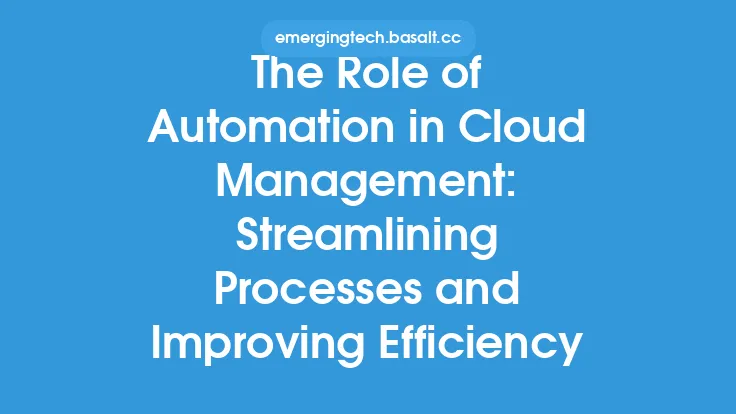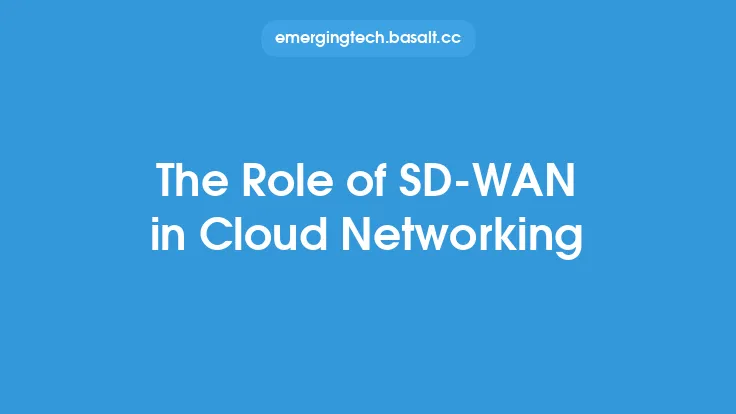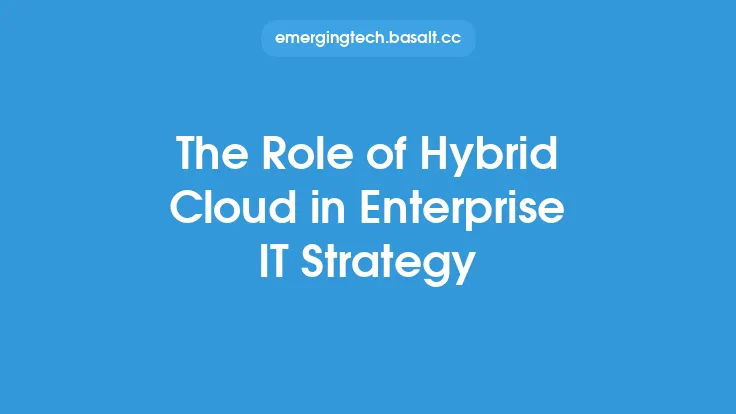As organizations continue to move their applications and data to the cloud, the process of cloud migration has become increasingly complex. One key factor that can simplify and accelerate this process is automation. Automation plays a crucial role in cloud migration, enabling businesses to streamline their migration processes, reduce errors, and increase efficiency. In this article, we will explore the role of automation in cloud migration, its benefits, and how it can be implemented.
Introduction to Automation in Cloud Migration
Automation in cloud migration refers to the use of software tools and scripts to automate repetitive and time-consuming tasks, such as data transfer, application deployment, and configuration. Automation can be applied to various stages of the cloud migration process, including assessment, planning, execution, and testing. By automating these tasks, businesses can reduce the risk of human error, increase the speed of migration, and improve the overall quality of the migration process.
Benefits of Automation in Cloud Migration
The benefits of automation in cloud migration are numerous. Some of the most significant advantages include:
- Increased speed: Automation can significantly reduce the time it takes to complete a cloud migration project. By automating tasks such as data transfer and application deployment, businesses can migrate their applications and data to the cloud much faster.
- Improved accuracy: Automation reduces the risk of human error, which is a common cause of migration failures. By using automated tools and scripts, businesses can ensure that their applications and data are migrated correctly and consistently.
- Enhanced efficiency: Automation enables businesses to migrate their applications and data to the cloud with minimal manual intervention. This means that IT staff can focus on more strategic tasks, such as application development and innovation.
- Cost savings: Automation can help businesses reduce their cloud migration costs by minimizing the need for manual labor and reducing the risk of errors and rework.
Types of Automation in Cloud Migration
There are several types of automation that can be used in cloud migration, including:
- Script-based automation: This involves using scripts to automate specific tasks, such as data transfer and application deployment.
- Tool-based automation: This involves using specialized tools, such as migration software and automation platforms, to automate the migration process.
- Orchestration-based automation: This involves using orchestration tools to automate the entire migration process, from assessment to deployment.
Automation Tools and Platforms
There are many automation tools and platforms available that can be used to automate cloud migration. Some of the most popular tools include:
- AWS CloudFormation: This is a service offered by Amazon Web Services (AWS) that enables businesses to automate the deployment and configuration of their applications and infrastructure in the cloud.
- Azure Automation: This is a service offered by Microsoft Azure that enables businesses to automate the deployment and management of their applications and infrastructure in the cloud.
- Google Cloud Deployment Manager: This is a service offered by Google Cloud Platform that enables businesses to automate the deployment and configuration of their applications and infrastructure in the cloud.
- Migration software: There are many migration software tools available that can be used to automate the migration process, such as Riverbed, Carbonite, and Zerto.
Best Practices for Automation in Cloud Migration
To get the most out of automation in cloud migration, businesses should follow best practices, such as:
- Assessing their applications and data to determine which ones are suitable for automation
- Developing a comprehensive automation strategy that aligns with their business goals and objectives
- Selecting the right automation tools and platforms for their needs
- Testing and validating their automated migration processes to ensure they work correctly
- Monitoring and optimizing their automated migration processes to ensure they are running efficiently and effectively
Challenges and Limitations of Automation in Cloud Migration
While automation can simplify and accelerate the cloud migration process, there are also challenges and limitations to consider. Some of the most significant challenges include:
- Complexity: Automation can add complexity to the migration process, particularly if businesses are using multiple automation tools and platforms.
- Cost: Automation can require significant upfront investment, particularly if businesses are purchasing specialized automation tools and platforms.
- Security: Automation can introduce security risks, particularly if businesses are using automated tools and scripts to transfer sensitive data to the cloud.
- Dependence on technology: Automation can create dependence on technology, which can be a problem if businesses experience technical issues or downtime during the migration process.
Future of Automation in Cloud Migration
The future of automation in cloud migration is exciting and rapidly evolving. Some of the trends and developments that are expected to shape the future of automation in cloud migration include:
- Increased use of artificial intelligence (AI) and machine learning (ML) to automate the migration process
- Greater use of cloud-native automation tools and platforms
- Increased focus on security and compliance in automation
- Greater emphasis on automation as a key enabler of digital transformation and business innovation.
Conclusion
Automation plays a critical role in cloud migration, enabling businesses to streamline their migration processes, reduce errors, and increase efficiency. By understanding the benefits, types, and best practices of automation in cloud migration, businesses can unlock the full potential of the cloud and achieve their business goals and objectives. As the cloud migration landscape continues to evolve, it is likely that automation will become an even more essential component of successful cloud migration strategies.





